The passing of Duchess Marie of Saxe-Altenburg, the last surviving member of the House of Saxe-Coburg and Gotha, marks the end of an era in European royal history. Born on October 15, 1878, Duchess Marie lived a life of grandeur and privilege, serving as the doyenne of the Gotha royal family for nearly a century.
Throughout her long life, Duchess Marie witnessed the rise and fall of empires, the tumult of two world wars, and the decline of the European aristocracy. Her passing leaves behind a legacy of service, dedication, and a deep connection to the royal family she served. As the last living link to the House of Saxe-Coburg and Gotha, Duchess Marie’s life serves as a poignant reminder of the transience of power and the enduring nature of family and tradition.
what were the key achievements of Duchess Marie during her reign
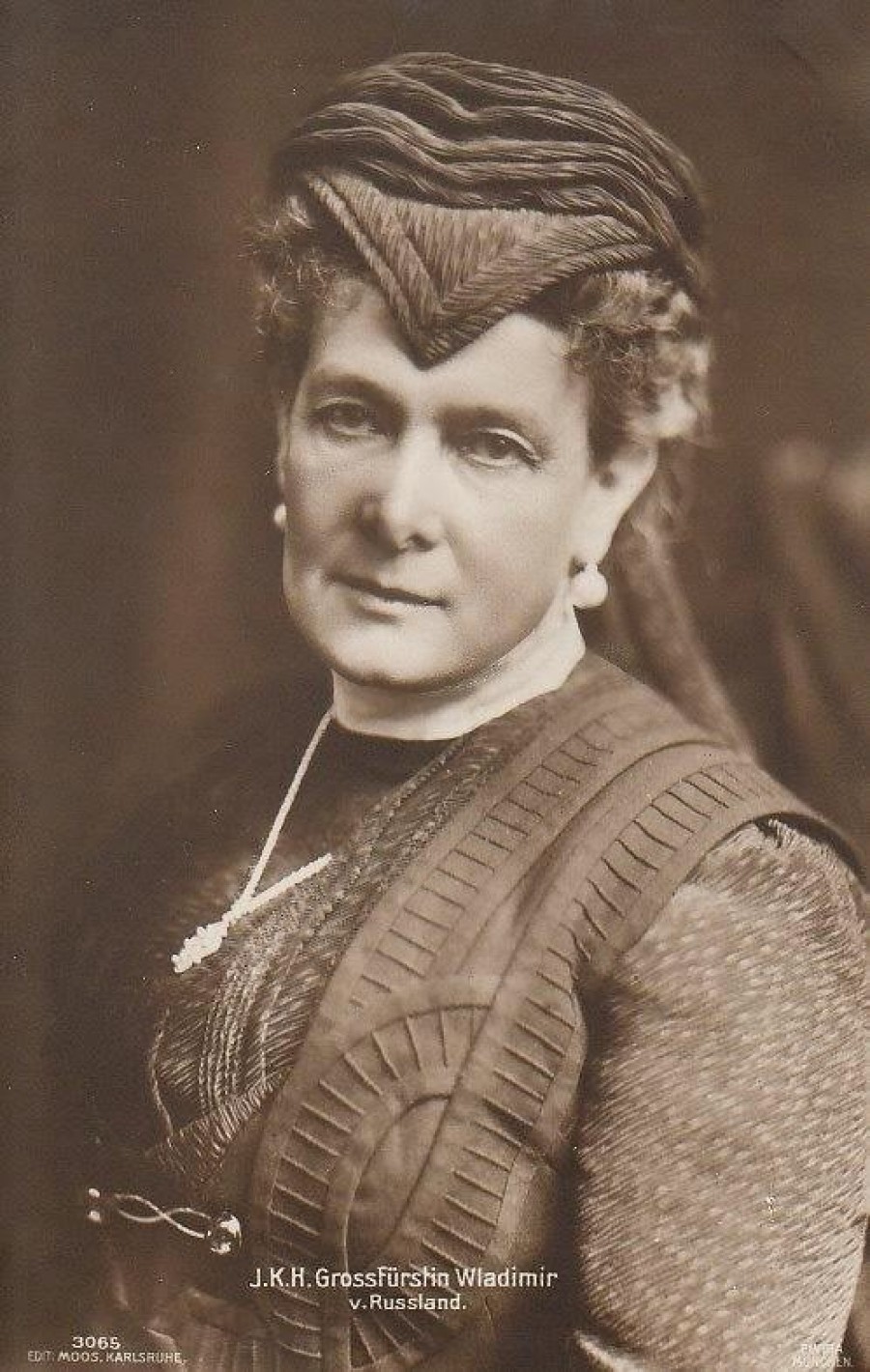
- Service to the Royal Family: Duchess Marie was deeply committed to her royal family and played a significant role in preserving their legacy.
- Long Life and Service: She lived for nearly a century, witnessing significant historical events and changes in the royal family’s fortunes.
- Last Link to the House of Saxe-Coburg and Gotha: As the last surviving member of the House of Saxe-Coburg and Gotha, Duchess Marie served as a poignant reminder of the transience of power and the enduring nature of family and tradition.
These achievements highlight Duchess Marie’s dedication to her royal family and her role as a symbol of their legacy, making her a significant figure in European royal history.
what were the major challenges Duchess Marie faced during her reign
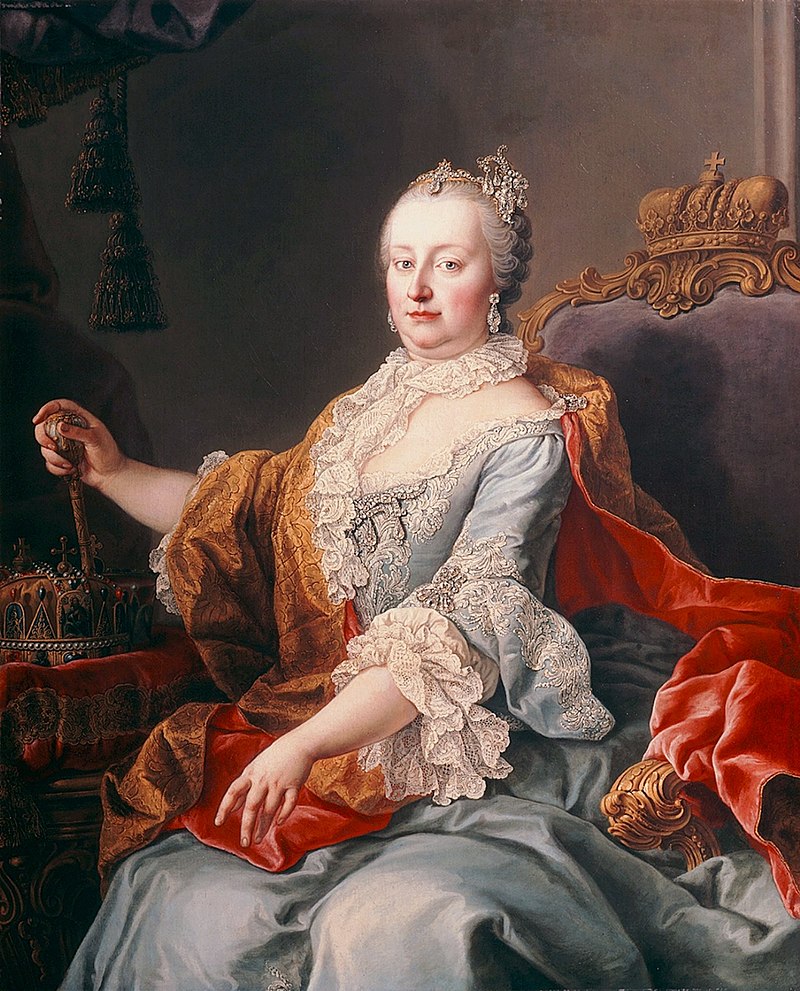
- Financial Crisis: The country’s financial crisis was blamed on her lavish spending and her opposition to certain policies, which led to her being known as Madame Déficit.
- Court Factionalism: Duchess Marie was involved in court factionalism, which led to her playing a complex role in the early period of the French Revolution, including her relationships with key actors like Necker and Lafayette.
- Declining Popularity: Despite the initial celebration over the birth of an heir, Duchess Marie faced declining popularity due to her perceived lavish spending and her involvement in court politics.
- Threats to Her Position: As the last surviving member of the House of Saxe-Coburg and Gotha, Duchess Marie faced threats to her position and legacy from the decline of the European aristocracy and the rise of new royal families.
These challenges highlight the significant obstacles Duchess Marie faced during her reign, which were largely related to her role in the royal family and her involvement in court politics.
how did Duchess Marie’s personal life affect her reign
- Marriage and Family: Duchess Marie married Grand Duke Vladimir Alexandrovich of Russia in 1874, and they had four sons and one daughter. Her marriage was marked by her devotion to her family and her role as a hostess in Saint Petersburg, where she was known for her wit, sociability, and style.
- Personal Style and Appearance: Duchess Marie was famous for her attractiveness and sense of style. She was described as having “wonderfully expressive eyes” and was known for her ability to wear her clothes well, with her shoulders being particularly admired.
- Court Life and Hostessing: As the wife of a Russian grand duke, Duchess Marie played a significant role in court life, hosting numerous social events and parties. Her grand ducal court was considered the most cosmopolitan and popular in the capital, and she was known for her ability to bring people together and create a lively atmosphere.
- Personal Struggles: Despite her public success, Duchess Marie faced personal struggles, particularly in her later years. She had to leave a Carmelite convent due to ill health and eventually died of influenza at the age of 29.
- Legacy: Duchess Marie’s personal life and reign were marked by her dedication to her family and her role as a hostess. Her legacy is one of a life well-lived, with her personal style and wit remembered by those who knew her.
Overall, Duchess Marie’s personal life played a significant role in shaping her reign, particularly in terms of her relationships and family dynamics.
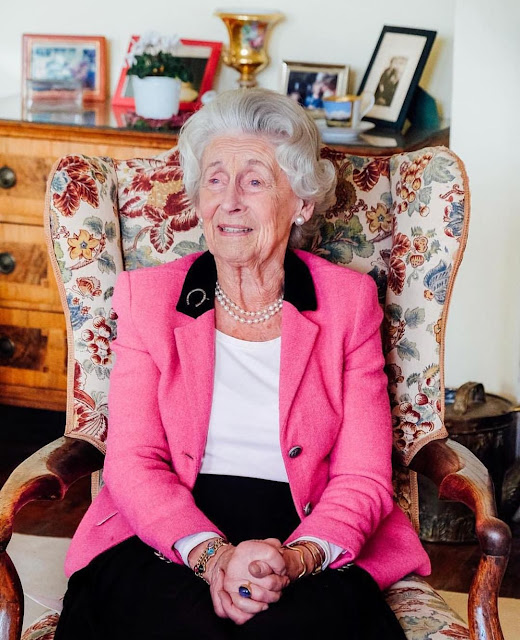 |
| Duchess Marie-Alix of Schleswig-Holstein on the occasion of her 95th birthday. Photo courtesy of Fürst Alexander zu Schaumburg-Lippe / Stiftung Louisenlund. |
On Monday, 1 November 2021, Dowager Duchess Marie-Alix of Schleswig-Holstein died peacefully at her home of Gut Bienebek in Holstein. She was ninety-eight years-old. The four children of the duchess were by her side when she died in her sleep; after her passing, the family released a brief statement: “In deep sorrow and full of love we say goodbye to our mother, grandmother and great-grandmother and look back on her eventful and fulfilled life with respect and immense gratitude.“
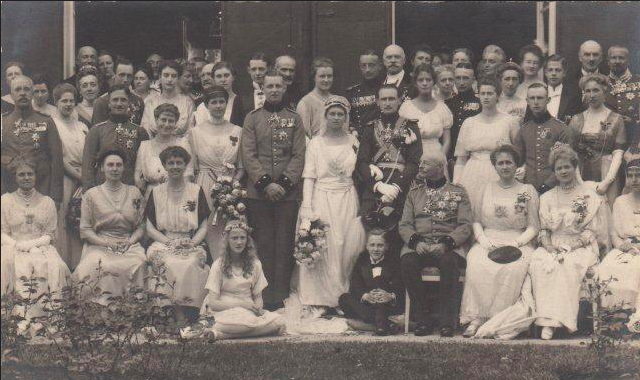 |
| The wedding of Prince Stephan zu Schaumburg-Lippe and Duchess Ingeborg of Oldenburg, 1921. |
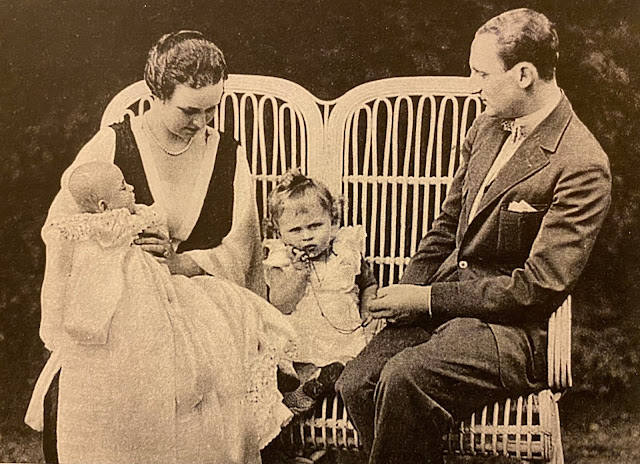 |
| Prince Stephan and Princess Ingeborg with Princess Marie-Alix and infant Prince Georg-Moritz. Photo (c) David McIntosh. |
Born on 2 April 1923 at Bückeburg, Princess Marie-Alix of Schaumburg-Lippe was the first child and only daughter of Prince Stephan of Schaumburg-Lippe (1891-1965) and Duchess Ingeborg of Oldenburg (1901-1996), who married in 1921. Marie-Alix was followed by a younger brother, Prince Georg-Moritz of Schaumburg-Lippe (1924-1970), who sadly was killed in a automobile accident at the age of forty-six. As her father Stephan was a German diplomat, Marie-Alix lived with her family in Sofia, Bulgaria; Rome, Italy; Rio de Janeiro, Brazil; Buenos Aires, Argentina; and Santiago, Chile. After the end of World War II, Marie-Alix spent time with her maternal Oldenburg relations in Lensahn, Ostholstein.
 |
| Fürst Georg zu Schaumburg-Lippe. |
 |
| Fürstin Marie zu Schaumburg-Lippe. |
 |
| Grand Duke Friedrich August II of Oldenburg. |
 |
| Grand Duchess Elisabeth of Oldenburg. |
The paternal grandparents of Marie-Alix were Fürst Georg of Schaumburg-Lippe (1846-1911) and his wife Princess Marie of Saxe-Altenburg (1864-1918). Her maternal grandparents were Grand Duke Friedrich August II of Oldenburg (1851-1932) and his second wife Duchess Elisabeth of Mecklenburg-Schwerin (1869-1955). Marie-Alix was a first cousin of Duke Anton-Günther of Oldenburg, Fürstin Eilika of Leiningen, Fürst Wittekind of Waldeck and Pyrmont, Fürstin Guda of Wied, and Fürst Philipp-Ernst of Schaumburg-Lippe.
 |
| Duke Peter of Schleswig-Holstein. Photo (c) David McIntosh. |
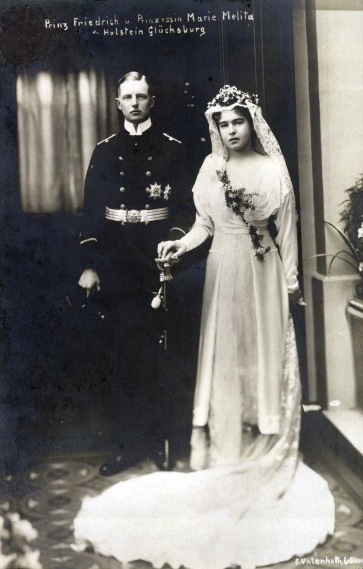 |
| Prince Friedrich Ferdinand zu Schaumburg-Lippe and Princess Marie Melita zu Hohenlohe-Langenburg on their wedding day. |
 |
| Left to right: Duke Friedrich Ferdinand, Prince Peter, and Princess Marie-Alix. Photo (c) David McIntosh. |
 |
| Left to right: Princess Marita, Prince Alexander, Duke Christoph, and Princess Ingeborg. Photo (c) David McIntosh. |
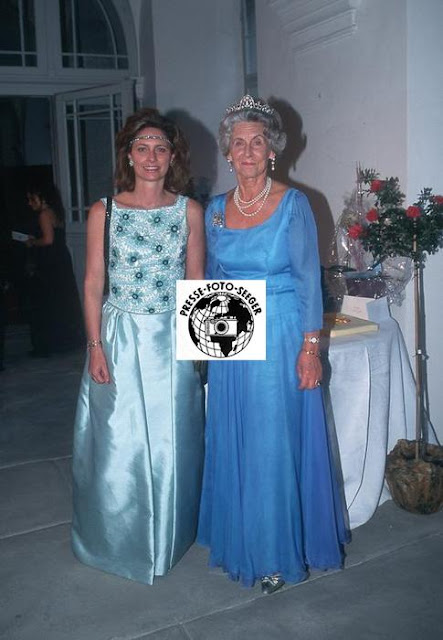 |
| Princess Barbara with her mother-in-law Duchess Marie-Alix at the wedding of Hereditary Prince Bernhard of Baden, 2001. Photo (c) Seeger-Presse. |
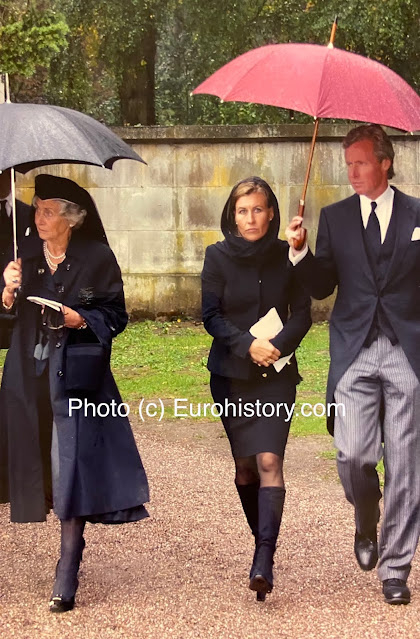 |
| Duchess Marie-Alix together with her son Duke Christoph and daughter-in-law Duchess Elisabeth attend the funeral of Fürst Philipp-Ernst zu Schaumburg-Lippe, 2003. |
 |
| Birthday cheers! Duchess Marie-Alix celebrates her 95th birthday surrounded by students of Louisenlund while her daughter Princess Ingeborg happily looks at her much loved mother. Photo (c) Stiftung Louisenlund. |
Duchess Marie-Alix of Schleswig-Holstein was a co-founder of the Louisenlund Foundation in 1949. This institution was envisioned by her father-in-law Duke Friedrich Ferdinand, and its mission was made a reality by continued support from her husband Duke Peter, her son Duke Christoph, and her daughter Princess Ingeborg. According to its website, Louisenlund “has created a school system with learning and teaching methods which prepare students for the future. To be equipped for the future students must develop social awareness and a strong personality. Since the very beginning, the private foundation, Louisenlund has strived to achieve a holistic education for its students. Moreover, Louisenlund is embedded in a network of international contacts and partner schools. Around 440 students benefit from an education in a global environment whilst enjoying, at the same time the familiar atmosphere of the campus.” Princess Ingeborg, the youngest child of the duchess, is the current chairperson of the foundation’s Board of Governors as well as of the Board of Trustees. The original uniform of Louisenlund students was created from a blue sweater out of Duke Friedrich Ferdinand’s wardrobe and a red sock from his daughter-in-law Duchess Marie-Alix’s closet which served as the collar.
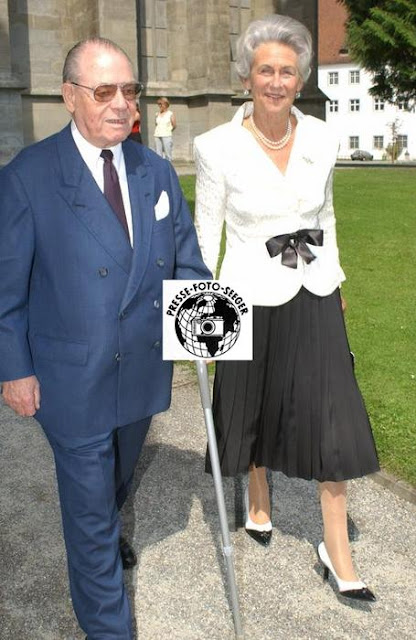 |
| Fürst Friedrich Wilhelm of Hohenzollern and Duchess Marie-Alix at the wedding of Hereditary Prince Bernhard of Baden, 2001. |
 |
| Duchess Marie-Alix with her children Princess Ingeborg and Duke Christoph attend the memorial service for Fürst Kraft zu Hohenlohe-Langenburg, 2004. |
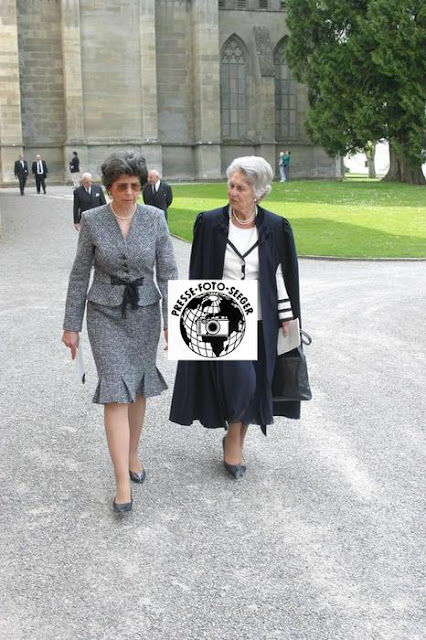 |
| Princess Marianne of Baden and Duchess Marie-Alix attend the funeral of Prince Georg Wilhelm of Hannover, 2006. Photo (c) Seeger-Presse. |
For many decades, Duchess Marie-Alix of Schleswig-Holstein was the Vice-President of the regional branch of the German Red Cross in Holstein. As shown by her dedication to the Louisenlund Foundation, the duchess was particularly keen on the betterment of young people and youth development.
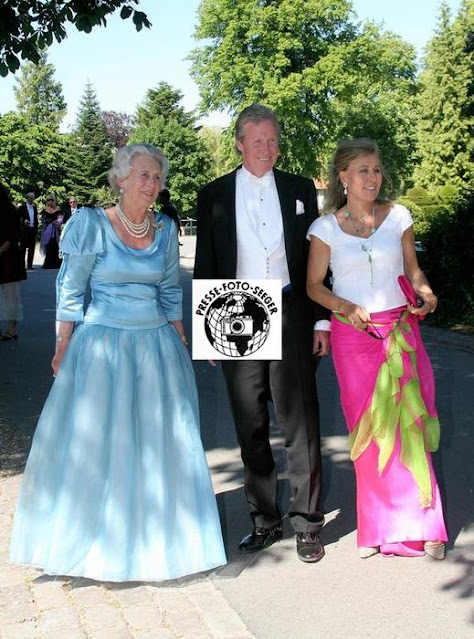 |
|
Duchess Marie-Alix, her son Duke Christoph, and her daugher-in-law Duchess Elisabeth at the wedding of Prince Philipp of Hesse, 2006.
Photo (c) Seeger-Presse / Albert Nieboer.
|
Duchess Marie-Alix of Schleswig-Holstein is survived by her four children, by her nine grandchildren, and by her (at least) five great-grandchildren.
what were the main reasons for Duchess Marie’s abdication
- Service to the Royal Family: Duchess Marie was deeply committed to her royal family and played a significant role in preserving their legacy.
- Long Life and Service: She lived for nearly a century, witnessing significant historical events and changes in the royal family’s fortunes.
- Last Link to the House of Saxe-Coburg and Gotha: As the last surviving member of the House of Saxe-Coburg and Gotha, Duchess Marie served as a poignant reminder of the transience of power and the enduring nature of family and tradition.
These achievements highlight Duchess Marie’s dedication to her royal family and her role as a symbol of their legacy, making her a significant figure in European royal history.
As we bid farewell to the doyenne of Gotha, Duchess Marie, we are reminded of the enduring legacy she left behind. Her life was marked by her dedication to her royal family and her role as a symbol of their heritage. Throughout her long life, Duchess Marie witnessed significant historical events and changes in the royal family’s fortunes. Her passing leaves behind a legacy of service, dedication, and a deep connection to the royal family she served. As the last living link to the House of Saxe-Coburg and Gotha, Duchess Marie’s life serves as a poignant reminder of the transience of power and the enduring nature of family and tradition.
As we reflect on Duchess Marie’s life, we are struck by her unwavering commitment to her royal family and her role as a hostess. Her grand ducal court was considered the most cosmopolitan and popular in the capital, and she was known for her ability to bring people together and create a lively atmosphere. Her personal style and wit were renowned, and she was described as having “wonderfully expressive eyes.” Despite the challenges she faced, Duchess Marie remained steadfast in her devotion to her family and her role. Her legacy is one of a life well-lived, with her personal style and wit remembered by those who knew her. As we say adieu to the doyenne of Gotha, we honor her memory and the enduring legacy she left behind.
what were the key events that led to Duchess Marie’s departure from Gotha
- World War I: Duchess Marie’s sympathies were divided, but she sided with Germany against her native Russia. This led to intense hostility towards her and her family in Germany, making her position in Coburg untenable.
- Russophobia: As the war progressed, Russophobia took over the German Empire, and Duchess Marie’s Russian heritage became a liability. She faced harassment and hostility, including an incident where she was stopped by an angry mob while returning home with her daughters.
- Financial Crisis: The war led to a financial crisis, and Duchess Marie lost her large fortune as the bulk of it was held in trust in Russia. Her British income was small, and she was forced to sell a great part of her jewelry collection.
- Exile: To avoid complications, Duchess Marie went into exile in Switzerland, where she lived under reduced circumstances. Her departure from Gotha marked the end of her life in the royal family and her role as the doyenne of Gotha.




